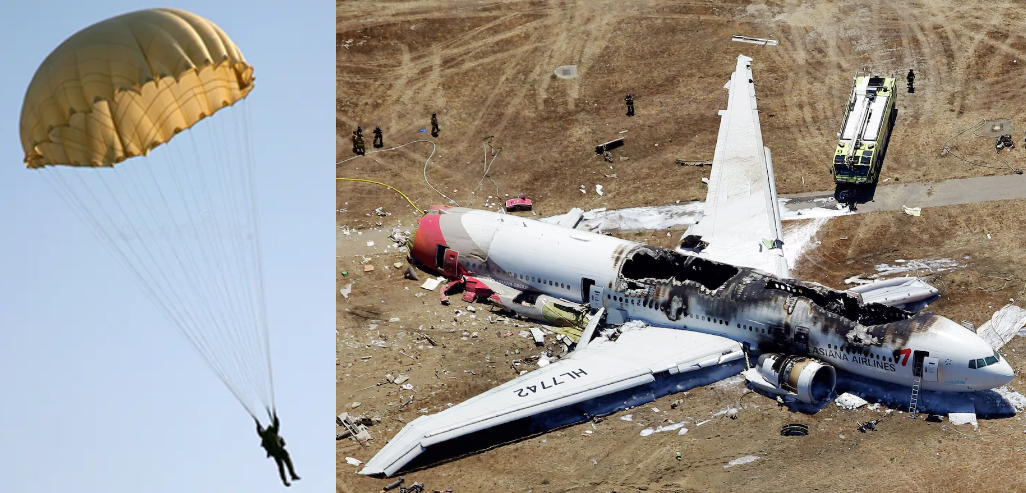Written by Mark Thompson.
In a bid to quell rising safety concerns, Boeing has unveiled its latest brainchild: parachutes for every passenger. No, you haven’t stepped into a Monty Python sketch; this is real. Boeing, the aviation behemoth, has decided that the best way to tackle safety issues is by transforming commercial flights into high-altitude carnival rides.
Imagine the scene: you’re comfortably settled into your cramped economy seat, munching on stale peanuts, when the flight attendant cheerfully announces the new safety procedure. “In the event of an emergency,” they say with a smile, “please grab your parachute from under your seat and prepare to jump.” It’s almost too ludicrous to comprehend. One can only imagine the pandemonium as hundreds of passengers scramble to strap on parachutes, mid-flight, while the plane nosedives toward the ground.
Critics are already having a field day with this idea. Aviation experts question the feasibility and safety of such a move, suggesting Boeing might be better off focusing on more conventional safety improvements. But Boeing, it seems, is determined to make air travel more exciting—whether passengers want it or not.
The Logistics of Mid-Air Parachuting: A Recipe for Chaos
Let’s break down the mechanics of Boeing’s grand plan. Engineers have reportedly spent countless hours designing parachutes that can handle the speed and weight of a descending airliner. The vision is that, in an emergency, passengers will calmly exit the plane, parachutes unfurling, and float gently to safety. Sounds serene, doesn’t it? Reality, however, promises something far more chaotic.
Picture the scene: the plane is in trouble, the captain gives the signal, and suddenly, hundreds of parachutes are deployed. Drinks spill, passengers tumble, and the once peaceful cabin becomes a scene of utter chaos. Boeing assures us that this is the pinnacle of safety innovation. Yet, one can’t help but wonder about the practicalities. How do you ensure everyone can correctly use a parachute under duress? Have they considered the sheer size and storage of these parachutes? And what about accidental deployments?
It’s almost as if Boeing is channeling its inner circus performer, juggling safety, logistics, and common sense. Rather than addressing engine failures or structural issues, they’ve decided to offer us a spectacle. But hey, at least you get a story to tell if you survive the experience.
Public Reaction: A Mix of Laughter and Dismay
The public’s reaction to Boeing’s parachute initiative has been a blend of amusement and disbelief. Social media platforms are teeming with jokes and memes, comparing Boeing’s parachutes to everything from party poppers to oversized kites. Aviation buffs and casual observers alike are reveling in the sheer absurdity of it all. It’s as if Boeing handed the world a golden ticket to comedy heaven.
Yet, beneath the laughter lies genuine concern. Many are questioning whether Boeing is truly committed to passenger safety or merely trying to divert attention from its ongoing issues. The company’s recent history is tarnished by accidents and safety failures, and this parachute gimmick does little to inspire confidence.
Passengers, understandably, are wary. The idea of relying on a parachute at 35,000 feet is far from reassuring. Instead of addressing the root causes of their safety problems, Boeing seems to be adding another layer of ridiculousness to an already fraught situation. It’s almost as if they’re hoping humor will mask the very real dangers still present.
Our Take
While Boeing’s parachute plan is undeniably entertaining, it is also deeply concerning. The company’s willingness to resort to such outlandish gimmicks rather than addressing fundamental safety issues is a clear indication that their priorities are misplaced. This is not the kind of innovation that will restore public trust or enhance aviation safety. Instead, it is a distraction that does little to solve the underlying problems. The public deserves better than this, and it is high time Boeing stopped playing games and started taking safety seriously.

